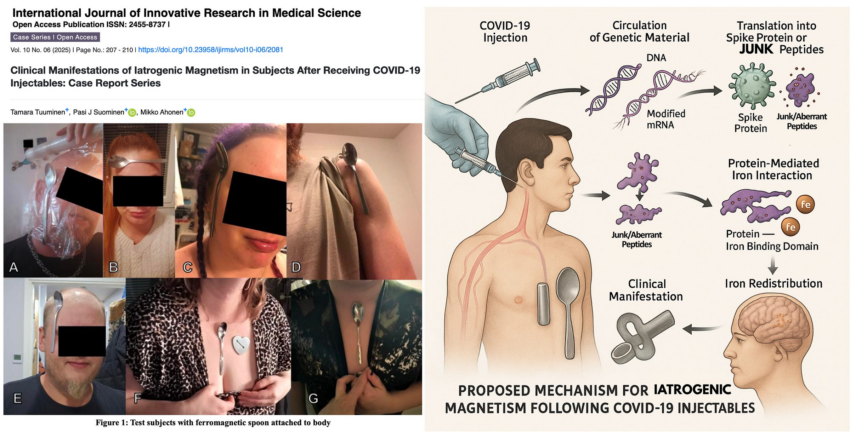By
This study has confirmed observations reported by many individuals since 2021. Let’s break down what the researchers found:
1. Iatrogenic Magnetism Is Real and Clinically Observable
-
Patients in this series demonstrated the attachment of ferromagnetic objects (e.g., spoons, magnets) to the skin—particularly the forehead, temples, chest, and shoulders.
-
This effect was physically verified by researchers, often with photo documentation.
2. Symptoms Emerge Months After Vaccination
-
Onset occurred typically 1–20 months post-injection, suggesting the phenomenon is not caused by residual components in the injection site but possibly from genetic expression or systemic distribution.
3. Potential Mechanism Involving Iron and Spike Protein
-
Authors hypothesize that injected DNA plasmids or modified mRNA may produce abnormal peptides or spike proteins that:
-
Exhibit ferromagnetic properties, or
-
Cause endogenous iron entrapment and redistribution.
-
-
The spike protein shares distant homology with hepcidin, a key regulator of iron metabolism, potentially leading to iron accumulation in tissues such as the brain.
4. Vaccine Lot Correlation
-
Pfizer lots beginning with the letter “F” were overrepresented in the cases observed.
-
Moderna vaccines were also used in some patients, but correlation was less frequent.
5. Clinical Effects and Reversibility
-
Some patients also experienced neurological and cardiovascular symptoms (e.g., arrhythmias, tremors, cognitive decline).
-
In at least two cases, oral NAD⁺ supplementation (500 mg/day) appeared to resolve or reduce symptoms, including magnetism.
The Cases
Case 1:
A 53-year-old male with no prior magnetism developed magnetic adhesion of a 25g object to both temples about 15 months after receiving two Pfizer injections (lots EY3014 and FE3065). He experienced chest pain, arrhythmia, full-body tremors, cognitive impairment, and other systemic symptoms.
Case 2:
A previously healthy 39-year-old female developed magnetism in her forehead and right shoulder—at the injection site—around one month after receiving a single Pfizer dose (lot FL4574). A 42g metal object adhered to her forehead, causing pain; symptoms lessened with alcohol and intensified during grounding.
Case 3:
A 28-year-old female developed magnetism approximately 20 months after receiving two Pfizer injections (lots FE2296 and FH0161). A 45g metal object adhered to her forehead, temple, and chest, but the magnetism faded over time, possibly due to self-initiated NAD⁺ therapy (500 mg/day).
Case 4:
A 28-year-old male reported magnetism of a 42g metal object to his left temple and ribcage around 20 months post-injection with both Pfizer (lot FH9951) and Moderna (lot 3004494). Cognitive symptoms and visual disturbances during MRI resolved with NAD⁺, but relapsed after discontinuation.
Case 5:
A 32-year-old previously healthy male—spouse of Case 2—developed magnetism two months after receiving the Pfizer vaccine (lot FL4574). A 70g metal object adhered to his forehead, chest, and shoulder opposite the injection site, with no improvement from food or medication.
Case 6:
A 36-year-old female developed strong magnetism (~25g object adherence to her sternum) one month after receiving Pfizer and Moderna vaccines (lots 1F1012A and 3006274). Her unvaccinated 10-year-old son also developed similar chest-localized magnetism, raising the possibility of vaccine-related shedding.
Implications for Medical Safety
-
Magnetism could complicate MRI procedures, posing additional risks.
-
No mention of this phenomenon exists in Pfizer’s internal documents or VAERS, despite numerous anecdotal reports.
-
The authors call for independent quality control testing of Pfizer vaccine lots—especially those labeled with “F”—and a larger cohort study to replicate findings.
This case series presents compelling evidence of iatrogenic magnetism following COVID-19 mRNA injections. While the mechanism remains speculative, the reported outcomes warrant immediate investigation. Regulatory authorities and independent researchers are urged to perform thorough analyses of suspect vaccine lots—especially in cases of unexplained metallic attraction or adverse MRI outcomes.
The authors concluded:
“The phenomenon of magnetism is real and not a nocebo effect.”
Epidemiologist and Foundation Administrator, McCullough Foundation
www.mcculloughfnd.org
Please consider following both the McCullough Foundation and my personal account on X (formerly Twitter) for further content.








